Something went wrong!
Hang in there while we get back on track
Best attractions in Siena

The Cathedral of Siena is undoubtedly one of Italy’s most impressive examples of Romanesque-Gothic architecture, rivaling, and perhaps even surpassing, the famed Cathedral of Florence in its splendor.
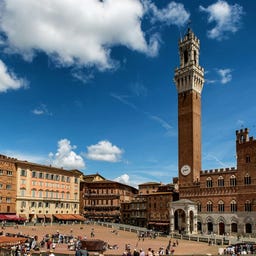
The heart of Siena enchants with its unique shell-shaped design and rich history. This iconic square, laid out in the 14th century, is best known as the site of the "Palio di Siena" horse race, held twice a year. You might recognize it from a James Bond movie, where Bond famously races across Siena's rooftops!
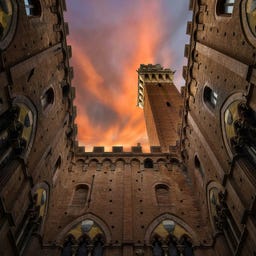
Der Torre del Mangia ragt imposant über der Piazza del Campo und symbolisiert die weltliche Macht von Siena im Mittelalter. Erbaut zwischen 1325 - 1344, wurde der Turm bewusst so hoch wie der Dom gestaltet, um das Gleichgewicht zwischen Kirche und Staat zu symbolisieren. Mit seinen 87 Metern (102 Meter inklusive Blitzableiter) ist er heute der dritthöchste mittelalterliche Turm in Italien. Ein besonderes Detail ist die weiße Travertinspitze, die später von Agostino di Giovanni hinzugefügt wurde.
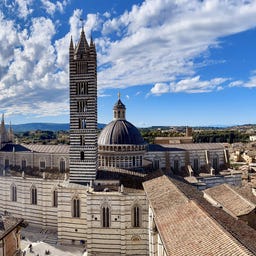
The Facciatone Terrace (= Façade) is a fascinating remnant of an unfinished cathedral expansion, offering a breathtaking 360-degree panoramic view of Siena and the surrounding Tuscan landscape. Conceived in the 14th century as part of a grander cathedral, the Facciatone now stands as a striking symbol of Siena's ambitious architectural vision. Its story is closely tied to the Great Plague of 1348, which abruptly halted construction, leaving behind this fascinating fragment of medieval ambition.
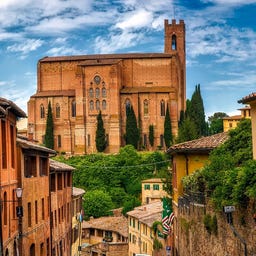
The powerful Basilica di San Domenico has been towering over the rooftops of Siena since the 13th century, offering you an impressive view of the Duomo and the Torre del Mangia. Built in a Gothic-Cistercian style, the church houses a special relic in its Renaissance chapel: the head of Saint Catherine of Siena.
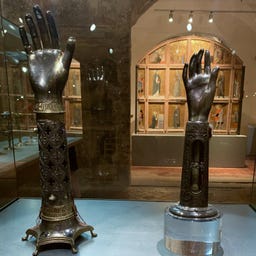
Despite its immense size, this sprawling museum remains quite unassuming from the outside. If you're spending more than a day in Siena, it’s well worth a visit. Just across from the cathedral, you’ll find one of the oldest hospitals in Europe, offering a fascinating labyrinth of corridors, halls, and underground tunnels. Among its highlights is the Pellegrinaio, a grand hall adorned with striking 15th-century frescoes. These artworks depict the life of the hospital brotherhood, offering a unique glimpse into medieval life and the social structures of the time. The museum also preserves valuable relics and artworks.
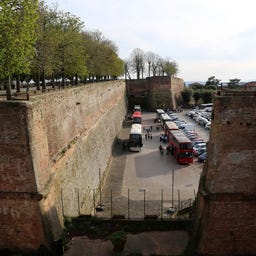
The powerful Fortezza Medicea stands as an impressive testament to Medici rule over Siena - built between 1561 and 1563 at the command of Cosimo I de' Medici to prevent further uprisings in the city. Designed by Baldassarre Lanci, the fortress captivates with its square shape, featuring four prominent bastions and extensive walkways, topped with the Medici family crest.
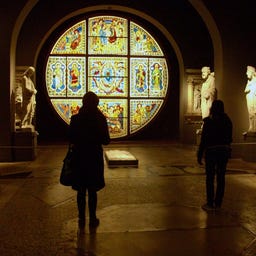
The Museo dell'Opera del Duomo, Italy's oldest private museum, preserves many of the original artworks from the cathedral. A major highlight is the access to the Facciatone Terrace on the top floor, where a fantastic panoramic view of the cathedral and Siena unfolds. Inside the museum, you'll find the impressive stained glass window by Duccio di Buoninsegna and numerous marble statues of prophets, philosophers, and sibyls.
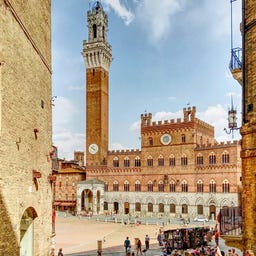
The majestic Palazzo Pubblico at the famous Piazza del Campo has been the political heart of Siena since its construction in the early 14th century and still houses the city administration today. In this impressive building with its characteristic brick and stone facade, you will find the Museo Civico, featuring significant masterpieces of Sienese art, including the famous frescoes by Ambrogio Lorenzetti and Simone Martini. The Torre del Mangia, built between 1325 and 1348, and the Cappella di Piazza, constructed in gratitude for the end of the plague, complete this unique ensemble of medieval architecture.
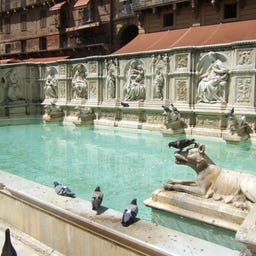
The monumental Fonte Gaia is one of the most significant fountains in Piazza del Campo in Siena, where it has been supplying water to the residents since 1346. The name "Gaia" (Joy) comes from the excitement of the citizens about the flowing water that was brought into the city through an impressive 30-kilometer-long aqueduct.
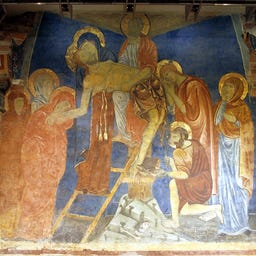
The Cripta del Duomo is a hidden gem, rediscovered only in 1999. This underground basilica boasts some of the most vibrant 13th-century frescoes, celebrated for their remarkably well-preserved colors. Initially used as an antechamber, it was forgotten after 14th-century construction work. The frescoes illustrate scenes from the Old and New Testaments, including the Crucifixion and Christ’s Burial, capturing the emotional depth of these biblical stories in vivid reds, blues, and gold.
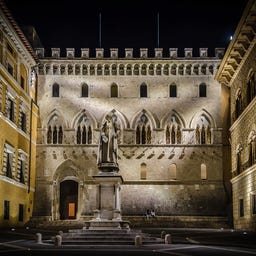
The impressive Palazzo Salimbeni has stood since the 14th century at the square of the same name in the heart of Siena and today houses the headquarters of the oldest still-existing bank in the world. What began as a fortress for the Salimbeni family evolved over the centuries from a city customs office to the seat of a welfare institution, until the Monte dei Paschi bank took over the building in 1866.
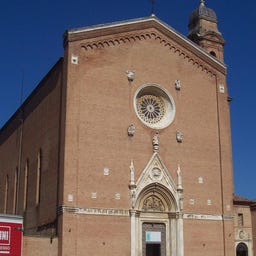
In the impressive Basilica di San Francesco, you encounter one of the most significant Franciscan sanctuaries of Siena, with a history dating back to the early 13th century. The neo-Gothic basilica, which took its current form between 1326 and 1475, captivates with its 36 magnificent Munich stained glass windows and the characteristic interplay of green and white marble, reminiscent of the Duomo di Siena.
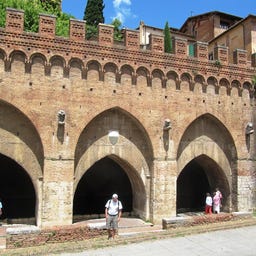
The impressive Fontebranda is one of the most significant medieval fountain systems in Siena, captivating visitors with its Gothic architecture featuring three large pointed arches, battlements, and lion-headed water spouts. Mentioned as early as the 11th century and rebuilt in brick and travertine by Giovanni di Stefano in 1246, it supplied the city with water through a 25-kilometer-long underground tunnel system.
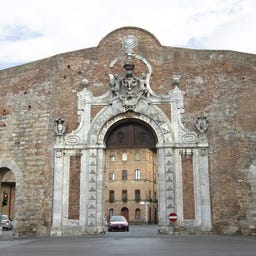
When you enter Siena through the Porta Camollia, you pass through what was once the main gate for travelers coming from Florence, known for centuries as the most heavily fortified city gate. The current structure dates back to 1604 and was designed by Alessandro Casolani after the original gate from the 13th century was destroyed during the siege of Siena in 1555.
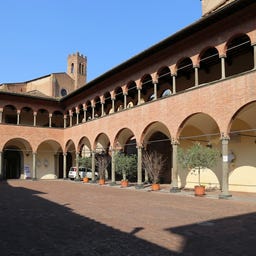
In the heart of Siena, you will find the Santuario di Santa Caterina, a fascinating complex of churches, loggias, and oratories that surrounds the birthplace of Saint Catherine of Siena. The site, which began renovations shortly after Catherine was canonized in 1461, combines elements of Renaissance, Baroque, and Neo-Renaissance architecture and houses significant artworks, including a miraculous crucifix from the 12th century.
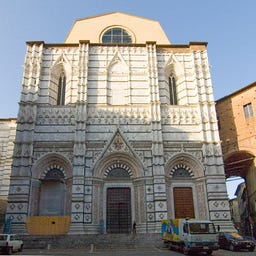
The Baptistery beneath the cathedral is a masterpiece of Italian Gothic architecture, constructed between 1316 - 1325. At its heart lies the central baptismal font, a hexagonal marvel of marble and bronze, crafted by some of the most prominent early Renaissance artists like Donatello and Ghiberti.
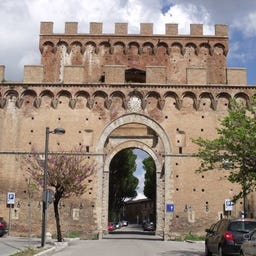
The Porta Romana is one of the historical city gates of Siena and was built between 1327 and 1328 by the architects Agnolo di Ventura and Agostino di Giovanni. This gate, which was once fortified with battlements and a forework, is located on the ancient Via Cassia and was part of the medieval city fortifications.
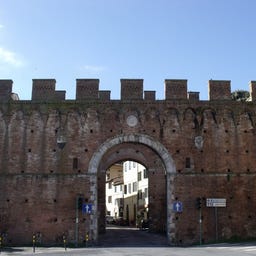
The Porta a Ovile is one of the best-preserved medieval city gates in Siena and was completed as early as 1246. In the 14th century, the gate underwent a significant renovation, featuring its characteristic battlement crown.
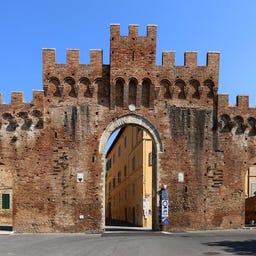
The Porta Tufi is one of the impressive medieval city gates of Siena, built between 1325 and 1326 under the guidance of the architect Agnolo di Ventura. As part of the last city wall, this brick gate still marks the historical entrance to the city on the Strada dei Tufi.
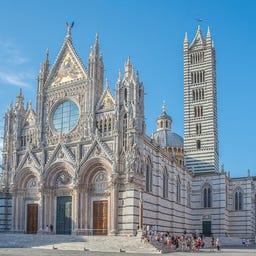
On the L-shaped Piazza del Duomo, the majestic Cathedral of Santa Maria Assunta rises, with a history dating back to the 7th century. The Gothic facade, a masterpiece by Giovanni Pisano and Camaino di Crescentino, is accessed by an impressive staircase adorned with intricate marble inlays from the 15th century. On the piazza, you will also find the former Hospital Santa Maria della Scala, one of the most significant medieval hospitals in Tuscany, as well as the powerful bell tower from the late 13th century, which was partially built on an even older tower of the Bisdomini.
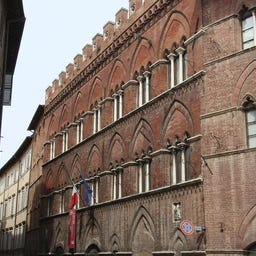
In Siena's most important state art collection, you can expect a fascinating journey through the city's art history from the 13th to the 18th century. The Pinacoteca Nazionale is housed in two historic palaces - the Palazzo Brigidi from the 14th century and the Palazzo Buonsignori from the 15th century, the latter of which is inspired by the striking facade of the medieval Palazzo Pubblico.
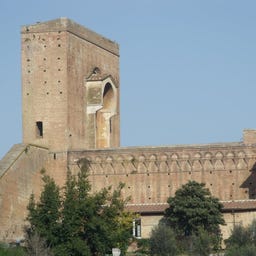
The Porta dei Pispini is one of the oldest city gates in Siena and was built as part of the last city wall starting in 1326. Originally known as Porta San Viene, its history is linked to the transfer of the relics of Saint Ansano in 1107. On the inner facade, there used to be a large fresco of the Nativity by Sodoma from 1530-31, the remnants of which can now be found in the Basilica San Francesco.
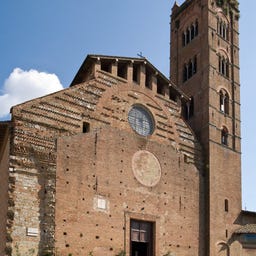
The majestic Basilica di San Clemente in Santa Maria dei Servi stands on a hill overlooking the Valdimontone district, combining Gothic, Renaissance, and Neo-Gothic architectural elements into an impressive whole. The construction of the church, dedicated to Saint Clement I, began around 1255 and spanned nearly three centuries, with the façade remaining unfinished to this day. Inside, you can discover art historical treasures such as the "Madonna del Bordone" by Coppo di Marcovaldo from 1261, as well as works by Matteo di Giovanni and Giovanni di Paolo. The Renaissance style of the three-nave main hall was shaped by Ventura Turapilli between 1471 and 1528, while in the 18th century, Baroque altars complemented the ensemble.
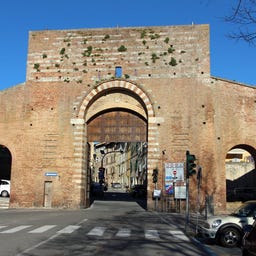
The Porta San Marco, also known as the "Porta delle Maremme," is a historic city gate from the early 14th century and part of the city wall of Siena. The gate, built between 1325 and 1326, was reinforced in the 16th century by the architect Baldassarre Peruzzi with additional fortifications.

The Chiesa di Santa Maria di Provenzano is one of the most important churches in Siena and was built between 1595 and 1611 according to the strict guidelines of the Counter-Reformation. Inside the single-nave church, with its distinctive travertine façade, you will find the revered Madonna di Provenzano, whose miraculous powers have been documented since 1594. The magnificent interior features paintings by renowned artists like Rutilio Manetti and an octagonal dome adorned with frescoes of Siena's patron saints. Since 1656, the church has been closely linked to the famous Palio di Siena, the traditional horse race that takes place here every year on July 2nd as its ceremonial highlight.
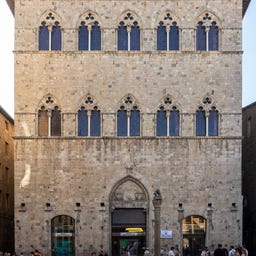
The Palazzo Tolomei is the oldest preserved private palace in Siena and has stood since the early 13th century along the Piazza Tolomei, which is part of the city's main route. The powerful Tolomei family, who came to Italy during the time of Charlemagne and rose to become influential bankers, had the palace rebuilt between 1270 and 1275 after it was destroyed by the Ghibellines.
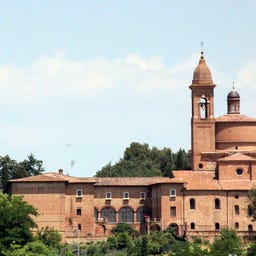
On the hill of Capriola stands the most significant church outside the city walls of Siena - the Basilica dell'Osservanza, dedicated to Saint Bernardino of Siena. This Renaissance church, built in the 15th century and featuring a distinctive dome, has a tumultuous history: after being damaged in wars during the 16th century and suffering severe bomb damage in World War II, it has always been rebuilt.
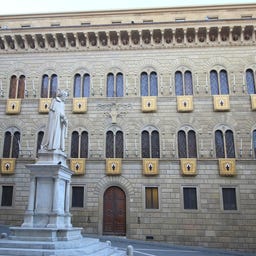
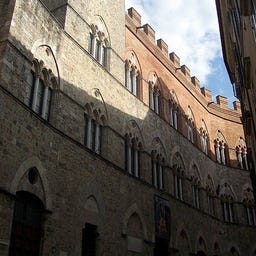
In the heart of Siena stands the Palazzo Chigi-Saracini, one of the most significant noble palaces in the city, with its oldest parts dating back to the 12th century. Originally built by the Marescotti family, the palace was expanded over the centuries by various noble families and received its impressive facade in the 18th century from the Saracini family.
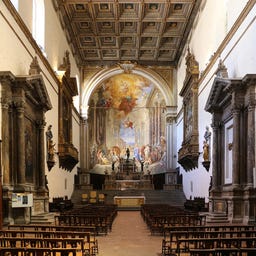
Directly opposite the impressive Siena Cathedral, you will discover the Chiesa della Santissima Annunziata, a historic church that originally served as a chapel for the famous Spedale di Santa Maria della Scala. This simple sacred building from the 13th century captivates with its single-nave layout, featuring an intricately coffered wooden ceiling and a raised main altar accessed by a wide staircase.

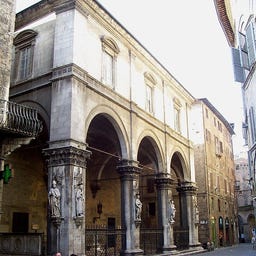
Right behind the famous Piazza del Campo, you will find the elegant Loggia della Mercanzia, an architectural gem that bridges Gothic and Renaissance styles. Built between 1417 and 1444 by Sano di Matteo and Pietro del Minella, the Loggia captivates with its three richly decorated arches and impressive statues of the city's patron saints.
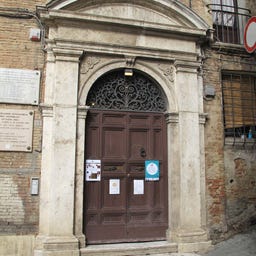
The Synagogue of Siena, built in 1786 by Giuseppe Del Rosso, is a fascinating example of the hidden places of worship from the Ghetto era: plain and unassuming on the outside, it reveals a richly decorated interior that combines Rococo and Classicism.
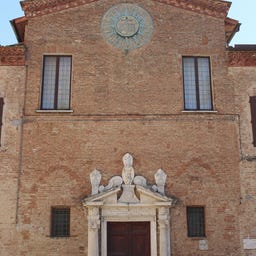
In the Oratorio della Compagnia di San Bernardino, a spiritual place from the 15th century where San Bernardino himself once preached, you will find the Diocesan Museum of Sacred Art today. The two-story building impresses with its distinctive brick facade and a travertine portal from 1574. On the upper floor, you can admire an impressive cycle of frescoes depicting scenes from the life of Mary, created between 1518 and 1532 by Sodoma, Girolamo del Pacchia, and Beccafumi. Among the most valuable treasures are a Byzantine icon of Mary from the 13th century and a panel featuring the trigram of San Bernardino, which is said to have belonged to the saint himself.
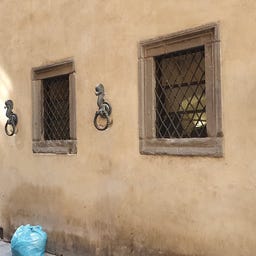
In the early 16th century, the powerful city lord Pandolfo Petrucci had this magnificent palace built as a symbol of his rule over Siena. Designed by Giacomo Cozzarelli, the palace impressed with its opulent decor, including a remarkable main hall featuring mythological ceiling paintings by Pinturicchio.
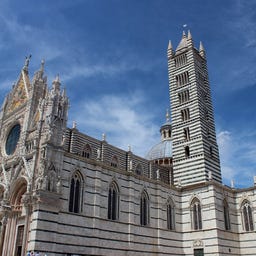
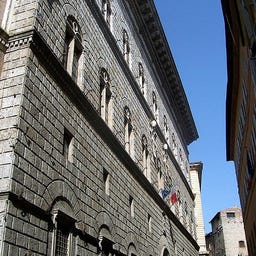
The Palazzo, built in the 15th century for the powerful banking family Piccolomini, impresses with its elegant stone facade featuring intricate bifora windows and wrought-iron decorations on the ground floor. Designed by Pietro Paolo Porrina in the Florentine Renaissance style, the building is architecturally inspired by the Palazzo Rucellai in Florence and the Palazzo Piccolomini in Pienza.
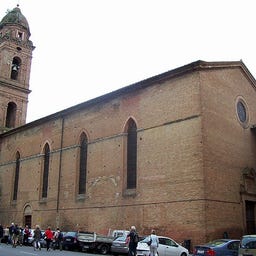
In the picturesque old town of Siena, the simple brick church Chiesa e convento di San Niccolò del Carmine rises with its distinctive square bell tower from the 17th century. The complex, built by Carmelite monks starting in the mid-13th century, houses impressive artworks, including paintings by Domenico Beccafumi and Sodoma.
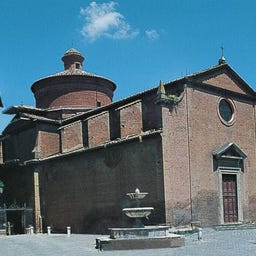
The Chiesa di Santo Spirito in Siena combines the artistic diversity of the Tuscan Renaissance with remarkable frescoes by Giovanni Antonio Bazzi and a rare painted terracotta nativity scene by Ambrogio della Robbia.
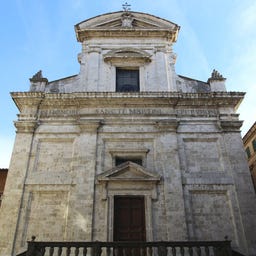
The Chiesa di San Martino is one of the most historically significant churches in Siena and has been documented since the 8th century. In its current form, it showcases a Renaissance structure with a Mannerist façade designed by Giovanni Fontana from the early 17th century, along with an impressive bell tower built in 1738.
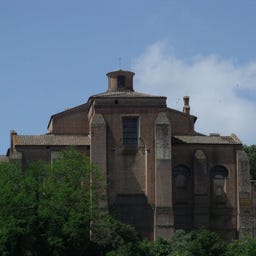
In the Church of Sant'Agostino, you will find a fascinating blend of Gothic and Baroque architecture, with a history dating back to 1258. Originally built by Augustinian monks, the church was given a neoclassical makeover by Luigi Vanvitelli after a fire in 1747, and today it impresses with a modern atrium that conceals the original terracotta façade.
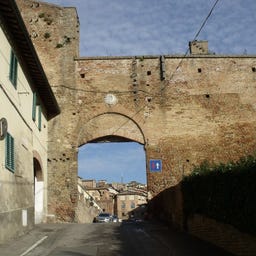
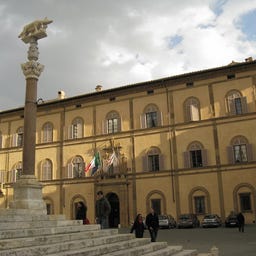
Directly opposite the impressive Cathedral of Santa Maria Assunta stands the Palazzo Reale, a historic city palace from the late 15th century. Originally built by Jacopo Petrucci as a private residence, the building came into the possession of the Medici at the end of the 16th century, who had it extensively expanded by the architect Bernardo Buontalenti. Under Tuscan rule, the palace served as the governor's residence and was particularly transformed into a magnificent residence during the tenure of Mattias de' Medici in the 17th century. Today, the building, also known as the "Palazzo del Governo," houses the prefecture and provincial administration of Siena.
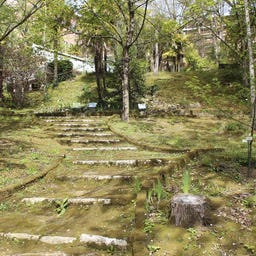
In the historic botanical garden of the University of Siena, founded in the early 17th century as a medicinal herb garden, you can explore three distinct areas across two and a half hectares: the "School," the "Park," and the "Podere."
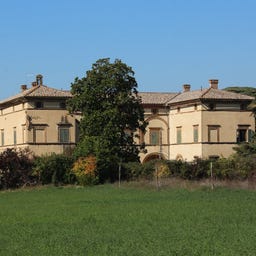
On a gentle hill between Siena and Sovicille stands the Villa Volte Alte, an architectural gem from the early 16th century. Commissioned by Mariano Chigi and designed in collaboration with Baldassarre Peruzzi, the villa is considered an important prototype of a building style influenced by Roman architecture, featuring projecting wings.
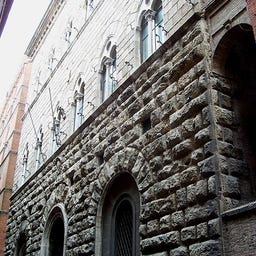
The Palazzo delle Papesse, built in the 15th century by Caterina Piccolomini, the sister of Pope Pius II, is an outstanding example of Florentine Renaissance architecture right in the heart of Siena. From the palace's rooftop terrace, none other than Galileo Galilei conducted his lunar observations in 1633.
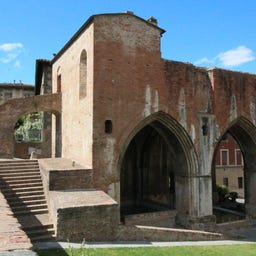
The Fonte Nuova is a historic water basin from the early 14th century that you can find on Via Pian d'Ovile in Siena. Built by Camaino di Crescentino and Sozzo Rustichini between 1298 and 1303, the fountain clearly shows the influence of Cistercian Gothic architecture.
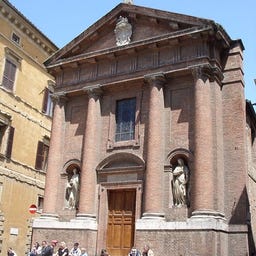
In the Chiesa di San Cristoforo at Piazza Tolomei, you can experience a fascinating piece of Sienese history, as this is where the citizens decided in 1260 to fight against Florence in the fateful Battle of Montaperti. The building, originally from the 11th-12th century, now features a neoclassical facade from the early 19th century, which had to be rebuilt after a devastating earthquake.
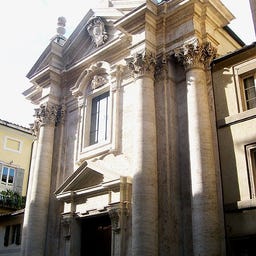
In the Church of San Giorgio, Romanesque and Baroque architecture blend together to create an impressive testament to Sienese history. The distinctive Gothic bell tower, with its 38 small windows, serves as a reminder of the victorious military companies in the Battle of Montaperti in 1260, for which the church was originally built. The current appearance is the result of a renovation in the 18th century by architect Gian Pietro Cremona, who adorned the façade with two powerful columns and the coat of arms of Cardinal Antonio Felice Zondadari. Inside, you will find significant artworks by the Vanni family, as well as a magnificent main altar painting by Sebastiano Conca, depicting the patron saint of the church in battle with a dragon.
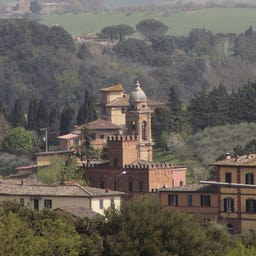
In the picturesque surroundings of Siena, you will find the Certosa di Maggiano, a former Carthusian monastery from the early 14th century, established by a donation from Cardinal Riccardo Petroni as a place for meditation and prayer. After a tumultuous history marked by a devastating fire during the Franco-Spanish War in 1554 and partial destruction under Leopold II of Tuscany, the building underwent extensive restoration in 1969.
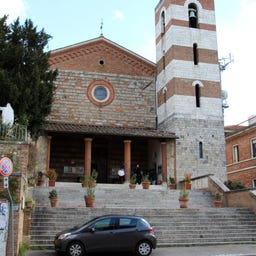
The Chiesa di Santa Petronilla in Siena has a rich history that spans from a Clarissan convent in the 16th century to a Capuchin monastery and finally to its current status as a parish church. After being destroyed during the siege of Siena in 1555, the church was rebuilt starting in 1622 and underwent extensive restorations in 1895, giving it its present appearance.
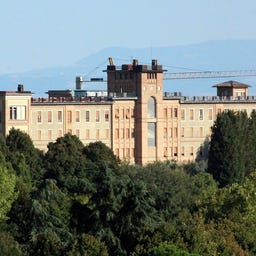
In the Villa Il Pavone, a square building with a characteristic columned portico in the Valli district of Siena, you will find one of the earliest romantic garden designs in the region. The architect Agostino Fantastici created the complex in 1825 on behalf of Mario Bianchi Bandinelli as a replacement for the original Palazzo del Pavone.
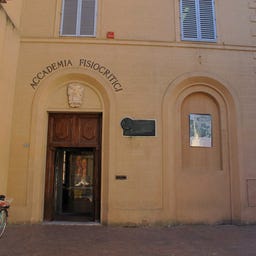
In a former 19th-century monastery, you will discover one of the most fascinating natural history museums in Tuscany, which has been part of the Accademia dei Fisiocritici since 1816. The historic display cases and the authentic atmosphere create a "museum within a museum" and present you with geological, zoological, anatomical, and botanical treasures from the region in four main sections.
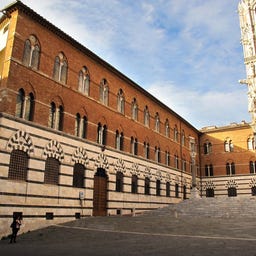
Right next to the impressive Siena Cathedral stands the Palazzo Arcivescovile, the historic residence of the archbishops of Siena-Colle di Val d'Elsa-Montalcino. The current palace was built starting in 1665 under Archbishop Ascanio II Piccolomini and received its distinctive black-and-white striped facade in the lower part between the late 17th and early 18th centuries. Inside, it houses a magnificent Baroque chapel from the 1720s dedicated to Saint Blaise, featuring significant artworks such as frescoes by Vincenzo Meucci. The chapel opens its doors to the public only once a year - on February 3rd for the feast of Saint Blaise.
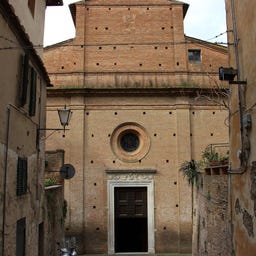
The Chiesa di Santa Maria in Portico Fontegiusta is an impressive testament to Siena's victory over Florence, built between 1479 and 1484 by Cristoforo Fedeli da Como as a church of gratitude. The Renaissance structure stands out with its unusual square layout, a result of the cramped space along the city wall, and its magnificent marble portal from 1489.
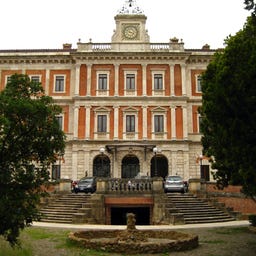
In the Tuscan city of Siena, you will find the Ex Ospedale Psichiatrico di San Niccolò, a fascinating testament to a tumultuous history: what began as a monastery in the 14th century was transformed into a psychiatric clinic in 1818 and now houses parts of the University of Siena.
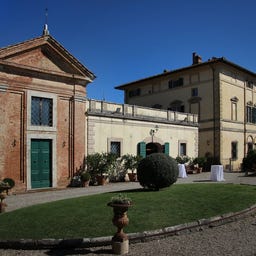
Just a few kilometers from Siena, you will find the Villa Chigi, an outstanding example of a 16th-century Renaissance country residence that is still owned by the Chigi-Zondadari family. Designed by Baldassarre Peruzzi, the rectangular building impresses with its elegant facade featuring three arcades and offers a stunning view of the Tuscan landscape all the way to Siena.
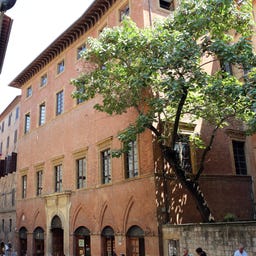
In the heart of Siena, you will find the Palazzo Patrizi, which once served as the city residence of the noble Patrizi family before they moved to Rome and Naples during the Renaissance. The palace is home to the historic Accademia degli Intronati, a cultural institution that has been active here since its founding in 1525.
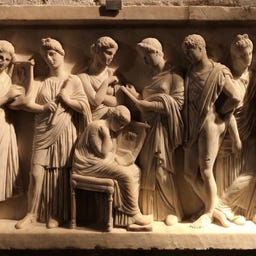
In the historic complex of the former Santa Maria della Scala hospital, you will find the National Archaeological Museum of Siena, which was established in 1933 by Ranuccio Bianchi Bandinelli as an Etruscan museum. The extensive collection, with its oldest pieces dating back to the Bronze Age, showcases significant finds from the Siena region, including Etruscan ceramics and Roman sarcophagi from the 3rd to 4th centuries AD. Particularly impressive are the architectural terracotta decorations from the 6th to 4th centuries BC and a large crater depicting the "Death of Egestus."

In the historic center of Siena stands the Castellare degli Ugurgieri, a unique example of medieval fortification architecture from the early 13th century. This well-preserved defensive structure, once the residence of the wealthy Ugurgieri family, is strategically located on the Via Francigena between Via San Vigilio and Via Angiolieri. With its tall walls, Gothic windows, and the still accessible family tower, it is the last of its kind in Siena. Today, the building houses the Contrada Priora della Civetta along with a museum that showcases an impressive collection of medieval and Renaissance ceramics.
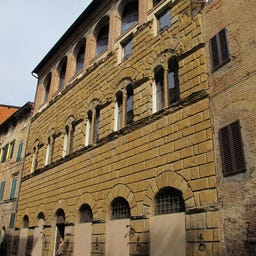
The impressive Palazzo San Galgano in the heart of Siena combines the architectural elegance of the 15th century with a rich history. Originally built as a city residence for the monks of the Abbey of San Galgano, the Palazzo still captivates with its sandstone façade in Florentine Renaissance style and the distinctive iron rings featuring sword symbols that pay homage to Saint Galgano.
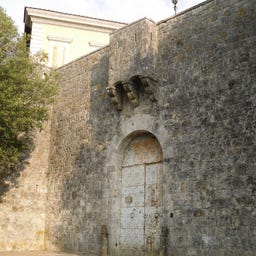
High above the hills of Siena stands the Castello di Belcaro, one of the best-preserved medieval fortifications in the region. The castle has a rich history that dates back to the 12th century, experiencing destruction during the conflicts between the Guelphs and Ghibellines, serving as a convent, and later being used as a military hospital during World War II.
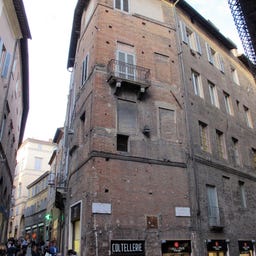
At the Croce del Travaglio, the historic crossroads of Siena, the three main streets of the city converge—just a short walk uphill from the famous Piazza del Campo.
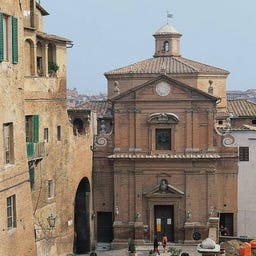
The Chiesa di San Giuseppe in Siena combines Renaissance and Baroque architecture into a harmonious whole that has shaped the city's skyline since the 16th century. The construction, initiated by Baldassarre Giusti di San Quirico d'Orcia, was originally commissioned by the carpenters' guild and impresses with its distinctive brick facade featuring a double order of pilasters.

Majestically, the Castello delle Quattro Torra rises on a hill near Siena, surrounded by olive groves and cypress trees. The distinctive brick building from the 14th century owes its name to the four prominent corner towers and originally served to defend Siena before being transformed into a country residence under the Medici.
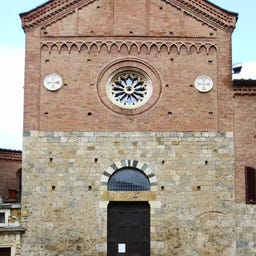
The Chiesa di San Donato has a rich history that began in the early 12th century as a Benedictine monastery and has transformed several times over the centuries. In its current form, it features a neo-Romanesque facade from the 1940s, while the interior is characterized by the magnificent Baroque style of the late 17th century.
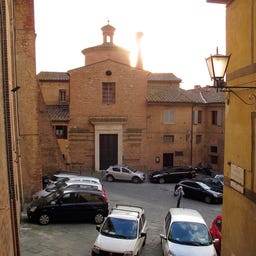
In the picturesque Piazzetta della Selva, you will discover the Chiesa di San Sebastiano, a Renaissance church with a distinctive dome based on a Greek cross layout. The construction, which began in 1493 according to the plans of Francesco di Giorgio Martini, houses remarkable artistic treasures, including the "Madonna della Selva" - a polychrome relief from the 15th century.

The Palazzo Tantucci, commissioned by Mariano Tantucci in 1548, presents itself to you today on Via dei Montanini with its striking facade facing Piazza Salimbeni. Built in the Mannerist style, the palace was designed by architect Bartolomeo Neroni and underwent extensive interior renovations in the 19th century by Giuseppe Partini.
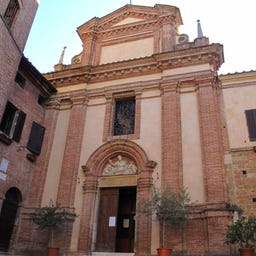
The Chiesa di San Pietro alle Scale, dating back to the 13th century, is mostly in the late Baroque style today, having undergone extensive renovations between the late 17th and early 18th centuries. Inside its single-nave interior, you can find remarkable art treasures from various periods, including a disassembled polyptych by Ambrogio Lorenzetti and a fresco fragment of Saint Catherine by Liberale da Verona from around 1470. The main altar is adorned with Rutilio Manetti's "Rest on the Flight into Egypt" (1621), while the characteristic brick façade features a relief depicting Saint Peter in glory among angels.
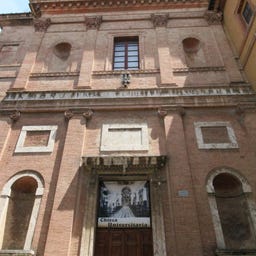
In the magnificent Baroque church Chiesa di San Vigilio, you will find an impressive collection of religious art from the 17th and 18th centuries. Founded in the 11th century by the Ugurgieri family, the church has a rich history, having been home to Camaldolese monks, Jesuits, and now serving as the university chapel of Siena.
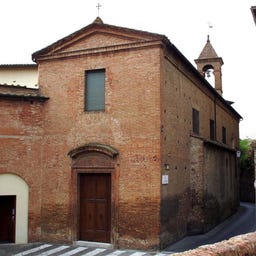
In the Church and Convent of San Girolamo, you will find a fascinating piece of Sienese church history that dates back to the 14th century. The complex, founded in 1354 by Francesco di Pietro Porcari, was expanded in the 15th century and now houses remarkable art treasures, including frescoes by Fra' Giuliano da Firenze and Rutilio Manetti. After a tumultuous history marked by Spanish occupation in the 16th century and various religious orders, the single-nave church received its current neo-Gothic appearance in the mid-19th century through the Daughters of Charity.
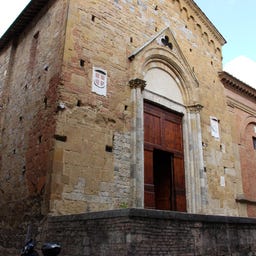
In the Church of San Pietro alla Magione, you encounter a fascinating piece of Templar history that dates back to 998. This Romanesque stone church, with its Gothic portal and distinctive bell tower, served as a pilgrim hostel for the Knights Templar from the 12th century, as evidenced by several Templar crosses still carved into the outer walls today.
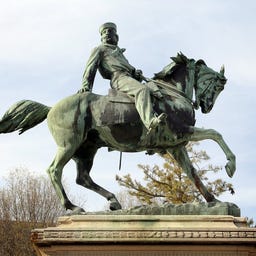
In the Giardini della Lizza of Siena, you can see the impressive equestrian statue honoring Giuseppe Garibaldi, which you can recognize from afar by its distinctive bronze figure. Unveiled in 1896, the monument depicts the Italian freedom fighter in his characteristic red uniform, commanding his troops from horseback.
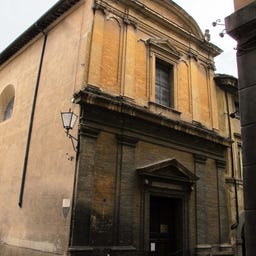
In the picturesque Via della Sapienza, you discover a special church that tells a fascinating story: Originally founded in the 13th century as a hospital, the Chiesa di San Pellegrino was extensively remodeled in 1767 and now impresses with its magnificent white and gold Baroque stuccoes.
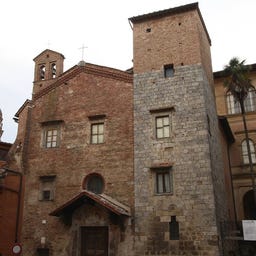
In this small church from the 15th century, according to tradition, Saint Ansano, the patron saint of Siena, was held captive by the Roman authorities before his martyrdom in the 4th century.
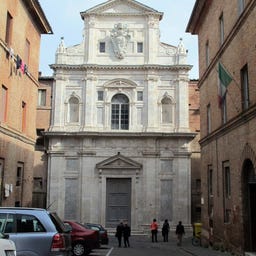
The Chiesa di San Raimondo al Refugio in Siena impresses with its magnificent Baroque marble facade, completed under the direction of the later Pope Fabio Chigi by 1660. The construction of the church began as early as 1601 under the nobleman Aurelio Chigi and today captivates visitors with an exceptionally well-preserved interior featuring decorations from the early 17th century.
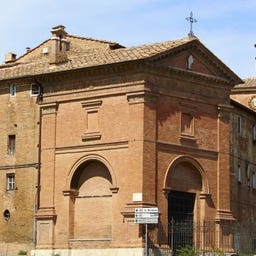
Right outside the gates of Siena, near the Porta Camollia, stands the mysterious Palazzo dei Diavoli from the 14th century. Originally built by the Turchi family and later owned by the Buonsignori, this brick palace got its name "Palace of the Devils" due to mysterious occurrences in 1526, when reports of red lights and strange noises emerged from the building.
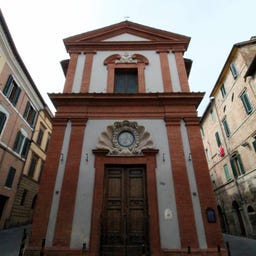
In Via dei Pispini, you will find the simple yet elegant Chiesa di San Gaetano di Thiene, which has served as the oratory of the Nobile Contrada del Nicchio since its completion in 1705. The church, whose construction began in 1683, impresses with its harmonious brick and plaster façade featuring a large stucco niche portal that displays a historic image of the Madonna. Inside, you can admire stunning decorations by Giuseppe Nicola and Apollonio Nasini, as well as a wooden statue of Saint Gaetano created by Aldo Marzi in 1957 at the main altar. The associated Contrada Museum houses an impressive collection of historical gold and majolica works.
At the intersection of important old town streets in the historic Terzo di Città, you will find the picturesque Piazza di Postierla, also known as the "Piazza dei Quattro Cantoni." In the center of the square stands a 15th-century column featuring Siena's symbol, the she-wolf, while an eagle fountain serves as the baptismal font for the Nobile Contrada dell'Aquila.
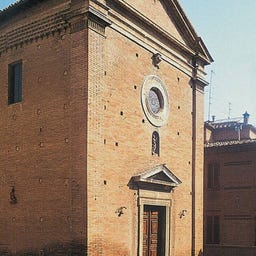
The simple oratory from the 16th century impresses with its completely frescoed interior, depicting biblical scenes and stories of saints. The brick building was originally constructed by the Brotherhood of Saint Roch and now houses the Contrada della Lupa, one of the historic city communities of Siena.
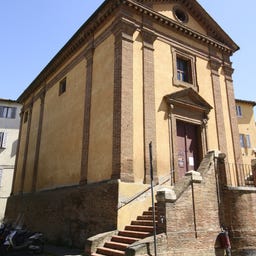
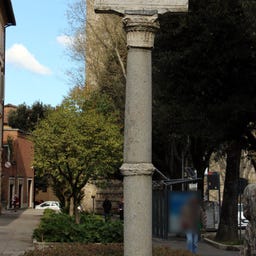
The "Colonna del Portogallo" is a monument in Siena, located on Viale Vittorio Emanuele II, between Porta Camollia and Antiporto di Camollia.

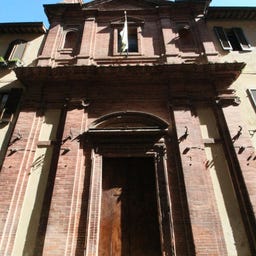
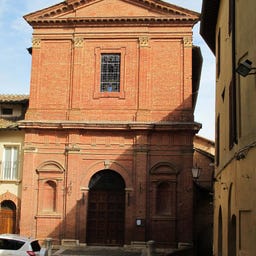

"Palazzo Buonsignori" is located in Siena on Via San Pietro. Together with Palazzo Brigidi, it houses the National Art Gallery of Siena.
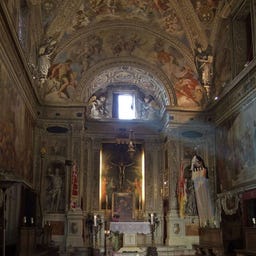
The "oratory of the Company of the Most Holy Trinity" is a church in Siena located on Via di Valdimontone, owned by the homonymous brotherhood and used as an oratory by the Contrada of Valdimontone.
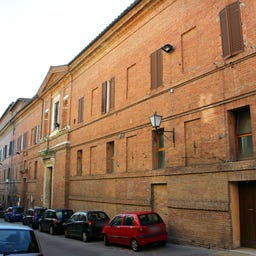
"Palazzo Cinughi de' Pazzi" is a historic building in Siena located on Via Banchi di Sopra, just a few steps from Palazzo Spannocchi and Palazzo Tolomei.
"Piazza San Francesco" is located in Siena, between the Borgo d'Ovile and the hill of Castellaccia.
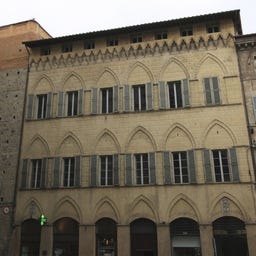
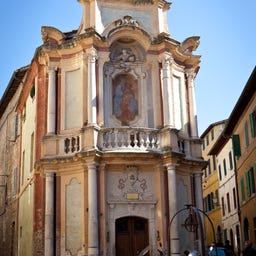
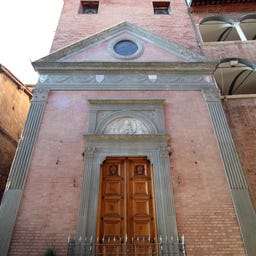
The "oratory of Santa Caterina in Fontebranda," also known as the "oratory of the Tintoria," is a small church located in Siena, on via Santa Caterina, and is owned by the Noble Contrada dell'Oca.
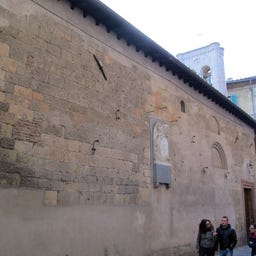
The "oratory of Saints Vincent and Athanasius" is a church in Siena, located on via Camollia, currently owned by and serving as the oratory of the Sovereign Contrada of the Porcupine.
The "Villa L'Apparita" is a historic country residence dating back to the 16th century. It is located about 3 km south of Siena, in the area of L'Apparita, in the heart of the Sienese countryside, and is particularly renowned for its garden designed by Pietro Porcinai.
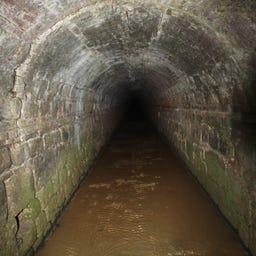
The "Canale del Granduca" is an underground canal in Siena.
